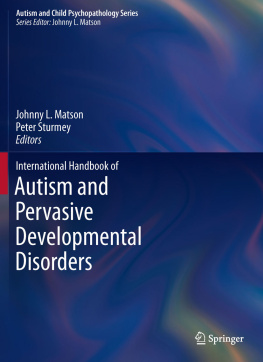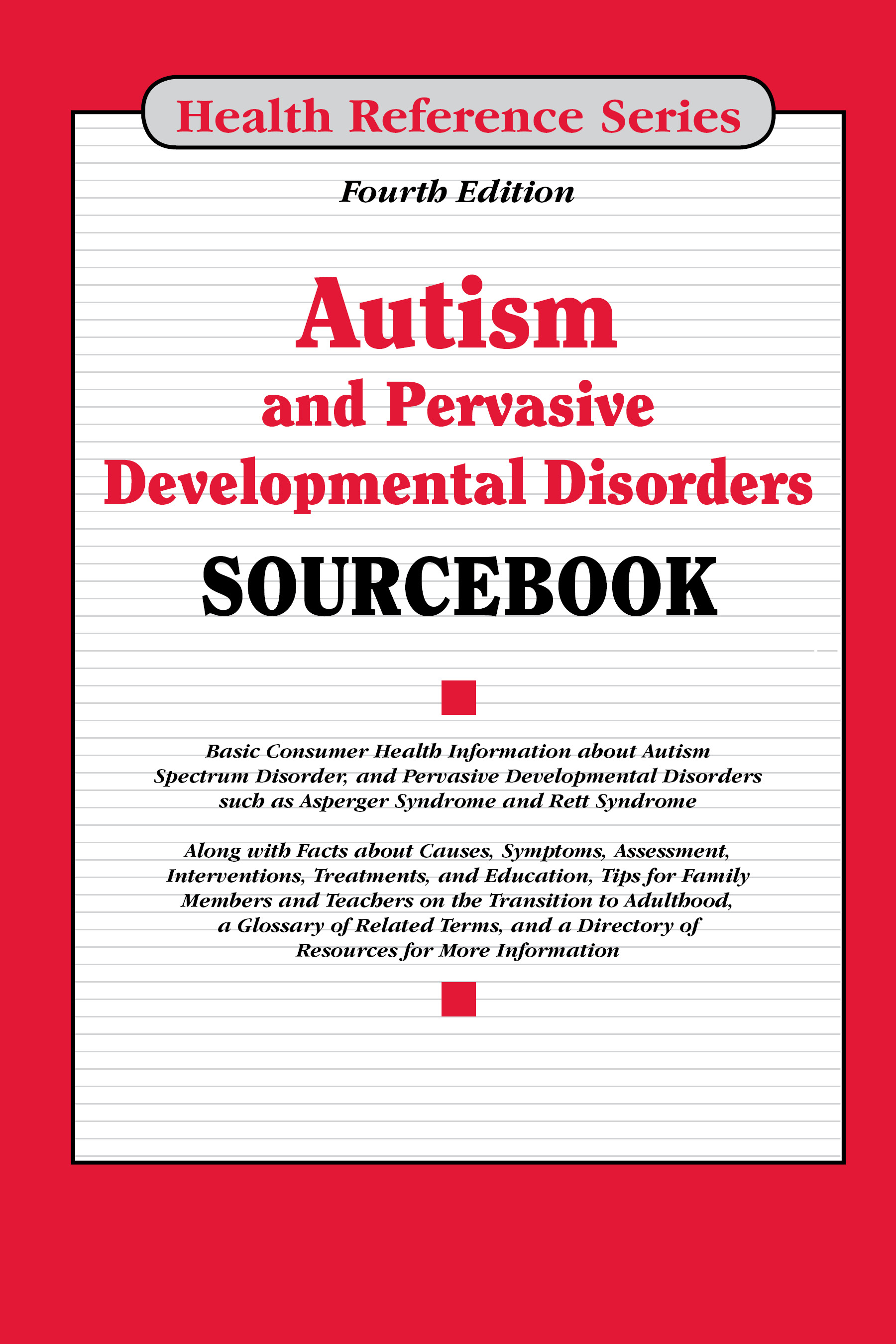Autism
and Pervasive
Developmental
Disorders
SOURCEBOOK
Fourth Edition
Health Reference Series
Fourth Edition
Autism
and Pervasive
Developmental
Disorders
SOURCEBOOK
Basic Consumer Health Information about Autism Spectrum Disorder, and Pervasive Developmental Disorders such as Asperger Syndrome and Rett Syndrome
Along with Facts about Causes, Symptoms, Assessment, Interventions, Treatments, and Education, Tips for Family Members and Teachers on the Transition to Adulthood, a Glossary of Related Terms, and a Directory of Resources for More Information

615 Griswold, Ste. 901, Detroit, MI 48226
Bibliographic Note
Because this page cannot legibly accommodate all the copyright notices, the Bibliographic Note portion of the Preface constitutes an extension of the copyright notice.
* * *
OMNIGRAPHICS
Angela L. Williams, Managing Editor
* * *
Copyright 2019 Omnigraphics
ISBN 978-0-7808-1656-5
E-ISBN 978-0-7808-1657-2
Library of Congress Cataloging-in-Publication Data
Names: Omnigraphics, Inc., issuing body.
Title: Autism and pervasive developmental disorders sourcebook : basic consumer health information about autism spectrum disorder, and pervasive developmental disorders such as asperger syndrome and rett syndrome, along with facts about causes, symptoms, assessment, interventions, treatments, and education. tips for family members and teachers on the transition to adulthood, a glossary of related terms, and a directory of resources for more information.
Description: 4th edition. | Detroit, MI : Omnigraphics, Inc., [2018] | Series: Health reference series
Identifiers: LCCN 2018042235 (print) | LCCN 2018043142 (ebook) | ISBN 9780780816572 (ebook) | ISBN 9780780816565 (hard cover : alk. paper)
Subjects: LCSH: Autism in children--Popular works. | Developmental disabilities--Popular works.
Classification: LCC RJ506.A9 (ebook) | LCC RJ506.A9 A8929 2018 (print) | DDC 618.92/85882--dc23
LC record available at https://lccn.loc.gov/2018042235
Electronic or mechanical reproduction, including photography, recording, or any other information storage and retrieval system for the purpose of resale is strictly prohibited without permission in writing from the publisher.
The information in this publication was compiled from the sources cited and from other sources considered reliable. While every possible effort has been made to ensure reliability, the publisher will not assume liability for damages caused by inaccuracies in the data, and makes no warranty, express or implied, on the accuracy of the information contained herein.

This book is printed on acid-free paper meeting the ANSI Z39.48 Standard. The infinity symbol that appears above indicates that the paper in this book meets that standard.
Printed in the United States
Preface
About This Book
The Centers for Disease Control and Prevention (CDC) reports that 1 in 59 children were identified with autism spectrum disorder (ASD). ASD includes autistic disorder, Asperger syndrome, Rett syndrome, childhood disintegrative disorder, and pervasive developmental disorder not otherwise specified. Studies indicate that the prevalence of these neurodevelopmental disabilities, which cause significant problems with social interaction and communication, is increasing. Researchers believe genes, brain dysfunction, and environmental factors play a role in causing ASD. Although there is no cure, early diagnosis and evidence-based interventions currently provide the best long-term outcomes.
Autism and Pervasive Developmental Disorders Sourcebook, Fourth Edition provides updated information about the specific types of ASDs. It explains symptoms, assessment, and diagnosis of ASD and describes the importance of early interventions. Evidence-based behavior, communication, and biomedical interventions are presented, along with educational guidelines for teachers and parents of children with ASD. Support, safety, transition, mental health, and employment information for families and individuals affected by ASD is also provided. The book concludes with a glossary of related terms and a directory of resources offer additional help and information.
How to Use This Book
This book is divided into parts and chapters. Parts focus on broad areas of interest. Chapters are devoted to single topics within a part.
describes autistic disorder, Asperger syndrome, Rett syndrome, and pervasive developmental disorder not otherwise specified. A separate chapter reviews the increasing prevalence and the diagnoses made for autism spectrum disorders in the United States.
reviews causes and risk factors for autism, prenatal inflammation and autism risk, and presents current research about the many genes linked to ASD. Risk factors for ASDincluding diseases, vaccines, premature birth, and early brain development risk factors for autism spectrum disorder are discussed.
describes the range of symptoms and developmental milestones and delays that indicate a need for further assessment of autism spectrum disorders. Developmental screening, medical and genetic tests, and other assessments are explained. The part also talks about speech and language development in children, diagnostic criterias, and measuring autistic intelligence.
provides information about communication difficulties, nonverbal learning disability, seizures, and epilepsy. Genetic disorders that co-occur with ASDsuch as Angelman syndrome, fragile X syndrome, Landau-Kleffner syndrome, and Prader-Willi syndromeare also explained. The part also talks about conditions that may occur with autism spectrum disorder such as thin bones and high growth hormone in boys.
gives detailed information about practices that are often effective for individuals with ASD. Topics include early intervention for children with developmental delays. Communication and behavior therapies such as applied behavior analysis, behavioral management therapy, cognitive behavior therapy, and joint attention therapy are described. Medical treatments, research study participation, communication therapies, and ASD medications are also discussed.
chapters address secondary school experiences, preparing ASD students for postsecondary education, and teaching lifetime goals.
provides practical information about safety and support for autism spectrum disorders adults focusing on specific concerns such as feeding and toilet training. The part also offers facts about oral care, transition plans, housing, career planning, and job accommodations for adults in the autism spectrum.
provides a glossary of terms related to ASDs. A directory of organizations with additional information about autism spectrum disorders is also included.
Bibliographic Note
This volume contains documents and excerpts from publications issued by the following U.S. government agencies: Administration for Children and Families (ACF); Centers for Disease Control and Prevention (CDC); Child Welfare Information Gateway; Effective Health Care Program; Eunice Kennedy Shriver National Institute of Child Health and Human Development (NICHD); Genetics Home Reference (GHR); Institute of Education Sciences (IES); National Aeronautics and Space Administration (NASA); National Council on Disability (NCD); National Human Genome Research Institute (NHGRI); National Institute of Dental and Craniofacial Research (NIDCR); National Institute of Environmental Health Sciences (NIEHS); National Institute of Mental Health (NIMH); National Institute of Neurological Disorders and Stroke (NINDS); National Institute of Standards and Technology (NIST); National Institute on Deafness and Other Communication Disorders (NIDCD); National Institutes of Health (NIH); Office of Minority Health (OMH); Office of the Assistant Secretary for Planning and Evaluation (ASPE); U.S. Bureau of Labor Statistics (BLS); U.S. Department of Education (ED); U.S. Department of Health and Human Services (HHS); U.S. Department of Labor (DOL); U.S. Environmental Protection Agency (EPA); U.S. Food and Drug Administration (FDA); and U.S. Office of Personnel Management (OPM).







